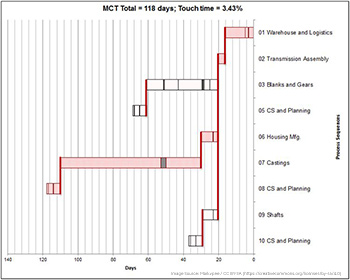Quick Response Manufacturing, or QRM, focuses on reducing lead and delivery times. This focus results in decreased production costs. The reduction in hidden costs is due to the reduced working process, fewer mistakes, and fewer complaint calls from customers due to late deliveries.
Customer satisfaction is one of the driving forces behind QRM. Fast response to customer's requirements is key. This response gives companies a competitive advantage by delivering products at reduced prices.
QRM analyzes how machines, people, and products interact to impact lead times. It is applied during planning for materials and control, office operations, as well as purchasing and supply chain management.
We've previously written about Quick Response Manufacturing here.
QRM Strategy
The development of QRM is based on four significant concepts aimed at eliminating waste while improving efficiency:
 The Power of Time
The Power of Time
Lead time is very critical in any organization, and all managers should realize its impacts on the business. Long lead times create additional costs in areas of planning, forecasting, lost sales, expediting, warehousing, and they cause obsolescence.
Reducing lead times leads to reduced overall enterprise costs.
Organization Restructuring
QRM transforms the organizational structure from the standard functional departments to smaller groups of employees with similar skills.
Implementing these groups throughout the entire organization gives employees more time to focus on their work, resulting in shorter lead times.
Using System Dynamics
QRM helps managers understand how factors such as batch sizes and capacity, affect lead times. Understanding these factors help them make better decisions.
For example, instead of maximizing machine and labor utilization, a manager instead chooses to invest in spare capacity reducing the cost of planning.
Organizational Implementation
Apply QRM throughout the whole enterprise from the shop floor to office operations. Quick response manufacturing reduces quoting and order processing times by up to 90%.
Implementing QRM
Applying QRM to the entire company helps reduce throughput time. If using it in every department, it may end up increasing the costs instead, which shouldn't be the case.
Achieving those targeted lead times means using analysis tools and techniques. Require management and employees to understand the company's manufacturing systems, which affect lead times.
 Quick Response Manufacturing aims at reducing the Manufacturing Critical-path Time (MCT). MCT is the time from when a customer makes an order to the time the product is delivered.
Quick Response Manufacturing aims at reducing the Manufacturing Critical-path Time (MCT). MCT is the time from when a customer makes an order to the time the product is delivered.
Paul Ericksen calls MCT a measure of true manufacturing lead time and defines it:
The typical amount of calendar time from when a customer creates an order, through the critical-path until the first, single piece of that order is delivered to the customer.
Saying this in a different way, MCT is the time it takes a manufacturer to satisfy unanticipated demand through normal processing. The phrase "normal processing" implies many things, including that the customer order is:
- Not treated as a "hot" job by being given priority to the detriment of other work already in the schedule.
- Not fulfilled through the use of pre-built, pre-positioned WIP, or finished product inventory.
Ericksen emphasizes an essential first step is identifying activities offering the best chance of reducing your true lead time. He provides two reasons why:
1) Lean activities today tend to be isolated events. As such, it can be difficult to consolidate the impacts of individual lean activities to a level that gets them recognition at the executive level. MCT reduction as an over-riding lean strategy prioritizes manufacturing improvement activities that will most impact order fulfillment capability. I guarantee that if you can tell the executives of your company that your work has maintained or increased company "customer fill rates" at the same time reducing necessary levels of pre-built, pre-positioned finished goods inventory, you'll have their attention.
2) Lead-times can represent a competitive advantage. If you are able to guarantee better support of customer unanticipated demand/unforecast orders than your competitors, you will increase your success at getting and retaining customers. Having a lean metric that is a measure of this competitive capability will only raise the level of appreciation of lean throughout both your internal organization and your potential customer base.
There are many examples of MCT mapping tools available to manufacturers. Some manufacturers created their own tool benefiting both them and their suppliers. John Deere offers such a tool.
The MCT (Manufacturing Critical-path Time) Mapping tool is available to help Suppliers in determining and logging the typical amount of calendar time from when a manufacturing order is created through the critical-path until the first, single piece of that order is delivered to the Customer.
The main inputs to this tool are times that have been gathered through observation or specific tracking of activities used to produce product. These activities are then grouped and defined as processes. These processes are then sequenced so that a flow from the original cut of a part through the complete build of a product can be defined to produce an MCT Map.
The tool was designed for simple and straightforward use. Additionally, ingrained in the tool is a significant amount of "how to" help.
A version of this tool has been used for several years by Deere Commercial & Consumer Product Division, which routinely has to support wide, short lead variations in consumer demand. The tool has been fundamental to that division's Order Fulfillment success.
To improve business processes, QRM overlaps with other methods like accounting methods, which determine the overall costs. It also overlaps with Value Stream Mapping, which identifies wasteful activities.
Multidisciplinary teams' formation is another essential tool, especially in business processes.
Benefits of QRM
Implementing Quick Response Manufacturing in your organization has significant benefits, which include:
Customer Satisfaction
By reducing lead times, you can deliver products to your customers faster. You are also likely to manufacture products according to customers' requirements and demands, increasing their satisfaction. Happier customers mean continued business as they are likely to return to buy from you in the future.
Increased Returns
Reduced lead times mean customers get their components faster. When they receive their orders faster, you get paid more quickly. This leads to an increasing cash flow. Prompt payment means adapting to market changes faster.
Competitive Advantage
QRM keeps the company on its toes, driving its innovation, and making it acquire and retain customers. Decreased lead time catapults innovation. Better lead times point to better quality, new product features, and better customer focus.
Apply QRM Today
Cost-saving is the number one priority for companies today. Reducing waste cuts manufacturing time, allowing delivery to customers faster. QRM helps reduce costs, increase customer satisfaction, and drive financial achievement. Choose a good QRM provider to help you start a system that helps reduce costs and you grow.